Table of Contents
Wisteria Bonsai is a plant species cultivated for its beautiful flamboyant flowers. The color of the flowers may be a mixture of Pink, Purple, Blue, White, and Yellow depending on which variety you have. There are less than three species of the tree throughout the world; with only the Japanese (Wisteria floribunda) and the Chinese (Wisteria Sinensis) variants widely used for Bonsai.
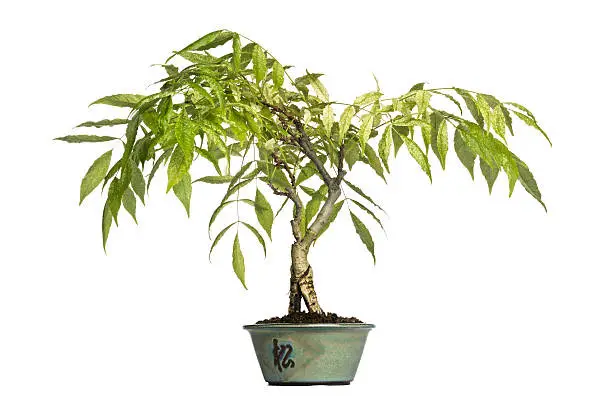
Although the Wisteria tree is a fast-growing plant, the secret to successful cultivation is patience and attention (care). In this I article, I will be sharing useful tips on how to plant this beautiful and dramatic tree in the best possible way.
| Scientific Name | Wisteria floribunda, Wisteria sinensis |
| Family | Fabaceae |
| Height | 305 to 762 cm |
| Spread | 122 to 243 cm |
| Bloom Time | May to June |
| Flowering color | Blue to violet, pink or white |
| Popular in | China, Japan |
| Watering needs | Moderate |
| Sun requirement | Full sun |
| Maintenance level | Hight |
Wisteria Bonsai history
The history of Wisteria Bonsai dates back to 1812 when a group of English agents finally gained access to China and Japan for trade; after a prolonged travel ban, restricting westerners from entering the countries. However, as at that time, only a little information was known about the tree species until the Japanese variant (Wisteria floribunda) was later introduced to the West by plant explorers from Asia.
During this time, the seeds of the Japanese species were exported largely from Japan and China. The first tree cultivated were propagated extensively by seed; with others being their direct descendants.
Many of the plants cultivated by seed are genetically different, with each offspring exhibiting unique characteristics. Even though these seeds were planted at large, the Wisteria growing industry remained small because, at that time, people had little or no control over the tree’s parentage until the modern American nursery was created which gave the industry a major boost.
It takes most Wisteria variants an average of 8 to 10 years after germination before they start to flower, but in some others, it could take them up to 20 years. This is usually a challenge to most plant enthusiasts though because they always find it difficult to distinguish between the seedlings until after 10 years of planting.
To solve the problem caused by the disparity in the blooming period, growers force the plant to bloom by cutting off its root. Although this method wouldn’t kill the tree, it sure is not the most healthy solution as the tree might permanently lose vital feeders’ root that is germane to its growth.
Some years later, after the first seedlings were cultivated in Europe, it was discovered that they were not as productive as their parents; consequently, plant hunters embarked on a journey to the far east, for the sole purpose of finding out the possible cause. Luckily, they were able to find out that the early flowery Asian trees were propagated by layering: a method used to propagate vines from cuttings.
This time, instead of sending seedlings back home, the plant collectors sent back rooted cuttings gotten from the best Chinese and Japanese trees. These cuttings were gathered from vulnerable trees found on historic sites, ancient places, and temples, giving the collectors renewed hope for early and ample bloom.
The cuttings were grown back home and growers were able to record remarkable changes in the overall level of productivity. This forms the basis for the distinctive growth habits of the species we have today.
Can we Bonsai Wisteria Tree
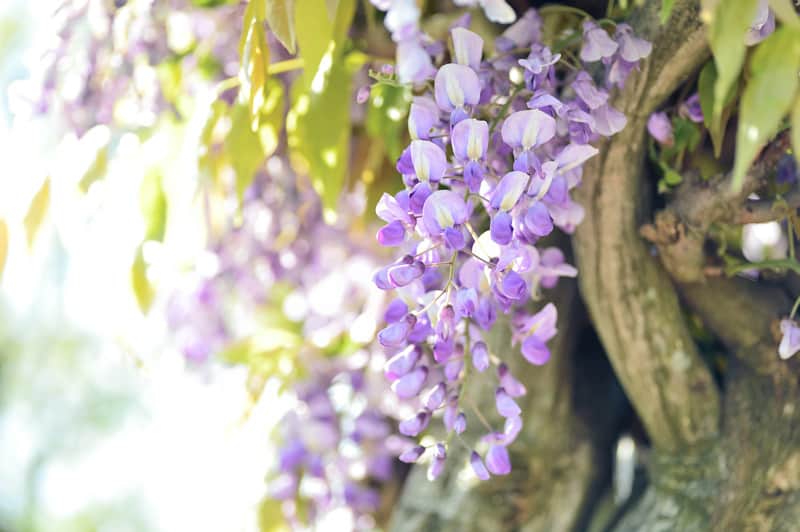
Yes, you can use the Wisteria tree in Bonsai. Many people use Wisteria trees for Bonsai because of their smelly attractive flowers. Also, they are fast-growing plants, which means they show results for every little effort quicker than some other tree species used in Bonsai.
Wisteria Bonsai scientific name
The scientific name for the Japanese Wisteria Bonsai tree is Wisteria floribunda; while the scientific name for the Chinese Wisteria Bonsai is Wisteria Sinensis.
Wisteria Bonsai symbolism
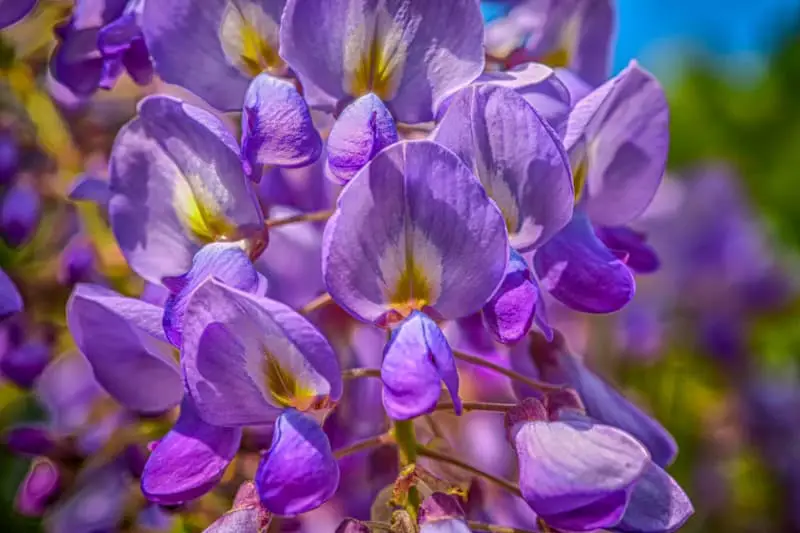
Wisteria Bonsai is of great essence to the Buddhist practice. This is so true of a particular sect called the Jodo Shinshu Shin Buddhists. To this sect, the Wisteria tree (Bonsai) signifies humility and is a symbol of prayer.
Although to some other belief, it signifies another thing entirely. For instance, in Victorian culture, Wisteria is seen as a sign of remonstration towards over passionate love. The meaning is said to have been derived from the natural tendencies of the tree’s vine to stick together till they choke.
Wisteria Bonsai care
Wisteria Bonsai may have showy flowers, but it sure is not something that can be easily achieved. Check successive sections to learn all that you need to know about the best way to treat your Wisteria Bonsai tree.
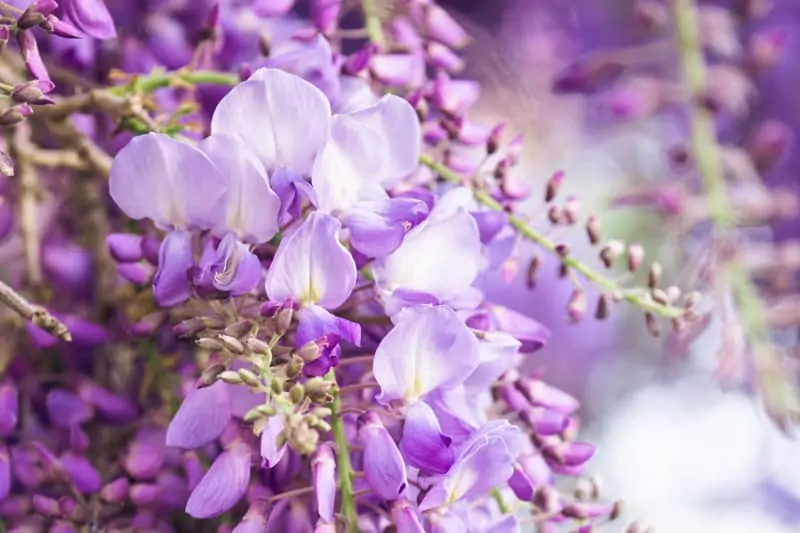
Wisteria Bonsai Temperature
The normal temperature level ideal for the growth of a Wisteria Bonsai is anything above 75 degrees.
Wisteria Bonsai fertilizer
You can use both solid and liquid fertilizers on a Wisteria Bonsai, but both are not to be applied similarly.
Apply liquid fertilizer to your Wisteria tree every week, and if you prefer solid fertilizers instead, they should be applied once a week. This should be done for both during the growing seasons.
Wisterias trees grow strongly and respond well to treatments, especially fertilizers. However, you must stay away from using fertilizers with high Nitrogen content; this is because most Wisteria species derive their Nitrogen naturally from the atmosphere: therefore, if you continue to feed them with Nitrogen-based fertilizers, it will become excessive and your tree will be forced to grow larger leaves instead of flowers and that will be a complete deviation from your original intentions.
What is the best fertilizer for Wisteria Bonsai
It doesn’t matter whether you feed your wisteria bonsai with a liquid or solid fertilizer, however, what is important and best for their growth is feeding them with fertilizers that are very low in Nitrogen.
Are banana skins good for Wisteria Bonsai
Yes, banana skins are good for Wisteria Bonsai. The best fertilizer to use for a Wisteria Bonsai is a fertilizer that is very low in Nitrogen. This is because the plant can naturally generate the much-needed nitrogen by itself. Banana skin does not contain Nitrogen but is rich in phosphorous, potassium, and calcium, some of the key nutrients that are germane for the growth of a Wisteria Bonsai.
Wisteria Bonsai pruning
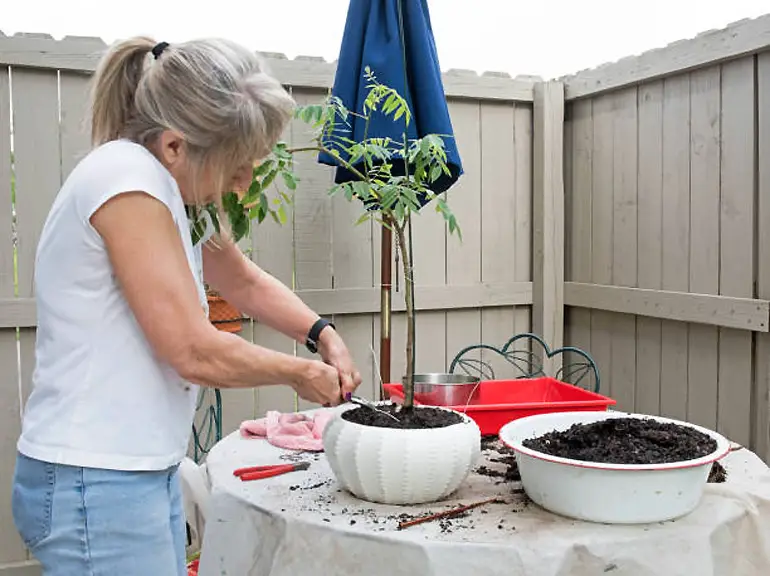
Just like many other Bonsai trees, pruning is also an essential part of a Wisteria Bandai. However, it is advisable not to completely prune your Wisteria tree because doing so will tamper with the growth cycle of your tree.
It is common for Wisteria trees to have thick covers during summer, and when this happens it will prevent inner twigs from having access to adequate sunlight. To correct this, it is recommended that you only trim down the leaves a little bit without going overboard (making the tree)
General pruning should be delayed till the tree undergoes a full flower bloom or early spring. Wait for the tendrils to start to grow around July before cutting them again. After completely removing the leaves, then you can start to print the twigs and the branches of the tree, then follow up by wiring the branch structure.
When pruning, you should be mindful of the short shoots supporting the flower buds because they are not to be cut off; their existence is crucial for the sustenance of new growths. You should be able to tell the difference between a flower bud and a leaf bud at a close look, so watch closely to avoid making mistakes.
Wisteria Bonsai repotting
It is best to report your Wisteria tree before the buds start to open up during summer.
Repotting should be done for younger Wisteria trees every 2 years and should be done every 3 to 5 years for older ones.
Younger Wisteria trees can withstand the shock of root pruning, but for the older ones, doing so could be detrimental. Therefore, it is advisable that you only prune their root when it seems necessary and must be done with the utmost caution; Wisteria trees flower best when their root is a little bit compacted to the soil.
Wisteria Bonsai pest & diseases
Wisteria Bonsai is a natural strong plant and has incredible immunity against every other kind of pest & disease except for the Powdery mildew and the leaf spot infection. Even at that, they show some resistance and it occurs infrequently. T
To curtail the menace of these pets, cut off infected leaves from an early stage. Eliminate the cankers and crown galls. Also when the soil of a Wisteria is soaked during winter, its root may start to rot, check if there’s any and get rid of decomposing roots.
You should also be on the lookout for Wisteria Borers: they are very dangerous and could kill your tree if their growth is left unchecked. To control them, you might have to get very strong chemical pesticides.
Wisteria Bonsai soil
Generally, Wisteria Bonsai are best planted in soil that retains water, so that the bed of the plant will never dry out. The pH of the soul must be between 5.5 to 6.
Wisteria Bonsai watering
Wisteria trees need a lot of water during it’s growing season, hence, they must be watered more frequently during that period.
To help keep the root of your plant moist during summer when the water dries out fast, make use of a shallow pot so that the pot collects enough water every time you water the plant.
During winter and autumn, you might have to be extra careful though because you will have to maintain a balance between total dry out and soggy soil.
Wisteria Bonsai sunlight
Well, it is no news that flowers flourishes with adequate sunlight, therefore, it is best to raise your Wisteria Bonsai under the full sun especially during its growing season.
Although when they are grown in non-Bonsai style, they are super hardy to frosty condition, when they to be planted in a pot or container (indoor), you must make sure that they are protected against frosty weather. You can place your Wisteria Bonsai in a moderately cold greenhouse, shed, or garage but you must not expose them to full winter frost.
Wisteria Bonsai Types
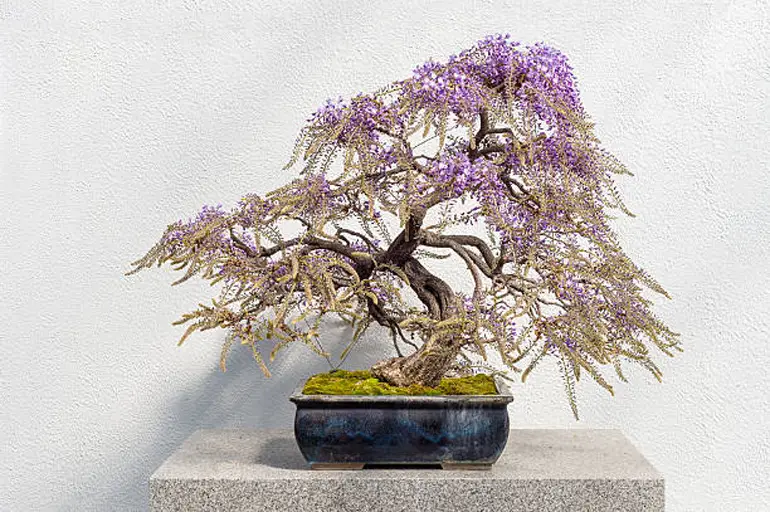
There are about 9 types of Wisteria tree, but here our focus will be on the few types which are commonly used for Bonsai. Check details about these various types below.
White Wisteria Bonsai
The white Wisteria Bonsai is a rare species of the Japanese Wisteria Bonsai. It usually has an assemblage of elongated white flowers which could be as long as 24 inches (60cm). The flowers have a pea-like fragrance and appear mostly towards the end of spring or early summer when the leaves usually open up.
Chinese Wisteria Bonsai
The Chinese Wisteria Bonsai is a deciduous vine that exhibits a twine-like growth pattern. They are the second most popular of the Wisteria species after the Japanese Wisteria. They are known for their elegant display of bluish-purple droopy fragrant flowers during May and June and they can grow as tall as 25 feet in the wild.
Dwarf Wisteria Bonsai
The Amethyst Falls is a variety of Wisteria trees commonly grown in a miniaturized form. Compared to their other Asian counterpart, Dwarf Wisteria are weaker (only in comparison as they are not weak plants) but are easier to control. They are early bloomers, as it is a special characteristic of the tree to start producing flowers right after the first year of planting.
The flowers are usually Lavander in color and troops down the tree branches during spring. Its leaves and flowers are smaller compared to other species and they can only grow as tall as 20 feet.
Wisteria Sinensis vs floribunda
The Wisteria scrubby plant had two main species – the Wisteria Sinensis (Chinese wisteria) and the Wisteria floribunda (Japanese wisteria). These two species require almost the same treatment, and for a novice, it could be difficult to pinpoint the difference between the two. Listed below are a few distinguishing factors between the two.
- The Japanese wisteria (floribunda) produces its flowers around May and extends towards June: whereas, the Chinese wisteria (sinensis) blooms mainly in May.
- The flower clusters of the Japanese wisteria (floribunda) are bigger, usually about 46cm wide: whereas that of the Chinese wisteria (sinensis) is usually smaller, growing up to just about 31cm in length.
- The flowers of the Japanese wisteria (floribunda) appear in wide ranges of colors ranging from shades of blue to white, and pink: whereas the Chinese wisteria (sinensis) usually appears mainly in two colors, white and lilac.
- The flowers of the Japanese wisteria (floribunda) start to bloom simultaneously as their leaves develop: whereas the flowers of the Chinese wisteria usually bloom before their leaves start to develop.
Is Wisteria Bonsai an indoor or outdoor plant
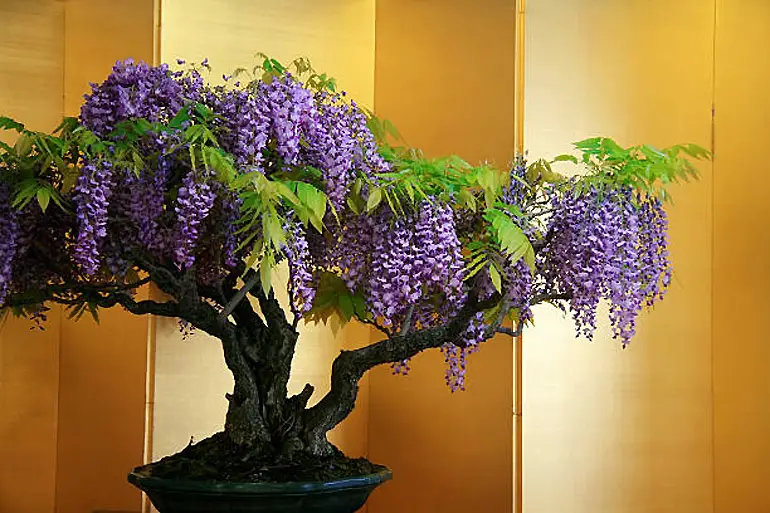
Wisteria Bonsai can be planted indoor or outdoor. However, how far they thrive whether planted indoors or outdoors depends largely on the tree species you have. For instance, the Japanese species will thrive better when grown outdoors. Because they need the full sun and the dormancy period of winter to grow healthily.
How to make a Wisteria Bonsai
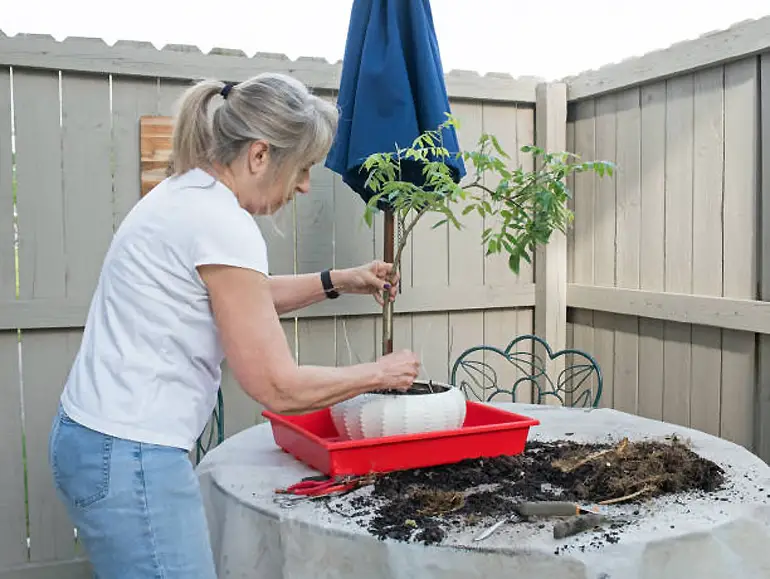
Discussed below are the necessary steps required to make a Bonsai tree.
Get softwood cuttings
You can get softwood cuttings from a Wisteria tree during summer. Just make sure the cuttings are put under a temperature level above 75°.
Plant the shoot
The shoot should be planted in a large container or pot so that the root can have enough space to expand throughout the year. And make sure the container is placed where it can be partly shaded from direct sunlight.
Trim to shape
To style the tree to your desired pattern, start shaping the trunk as early as the following spring right after planting when the plant has already grown an established root system with a Bonsai wire. The branches should be shaped only by pruning.
Transplant into a larger pot
When you noticed that the plant has grown up to 2ft and the branches have become thicker, transplant it to a larger pot with soil mix meant for growing Bonsai.
Remove dead roots
During the transplant, get rid of all dead roots and gently trim the live roots so they can fit into the pot. Although it is a normal practice to root prune Bonsai trees during spring, it is best to allow a Wisteria tree to become completely root bound before repotting.
Repot a yearly basis
Repotting should be done for a Wisteria Bonsai every other year immediately after flowering.
Wisteria Bonsai from cutting
After you’ve got the cutting from a healthy Wisteria Bonsai species of your choice, follow the steps below to guide you through the processes involved in propagating a Wisteria Bonsai by cuttings.
- Slightly bend the cutting and insert its halfway point in that position into a growing medium. The medium could be any of sand, a mixture of sand and peat, or peat and perlite mixtures as long as your choice will facilitate a balance between air circulation, drainage, and moisture.
- Ensure that there is enough space between each specimen so that each cam has equal access to adequate sunlight.
- Water your new plant, then cover it with a plastic clear bag and shield it from direct sunlight.
- Make sure the plant stays moistened until the root is firmly established.
Reference: Benefits of using perlite on bonsai trees
Wisteria Bonsai from seed
If you would like to monitor the growth of your Wisteria Bonsai as it progresses through its life stages, you can plant it from seed. However, you should know that propagating a Wisteria tree from seed usually takes time and you may have to wait for about 10 to 15 years before your tree could mature. If you are unbothered, follow the steps below to guide you through the processes involved.
- After getting the seed of your choice put them in water to test their viability. Dispose of the ones that are afloat, go through the process with those that sink.
- If you are working with dry seeds, weaken the outer layer of the seed to aid germination. You can do this by thinning the shell down using a blade or a file.
- Pour moisturized soilless seedling mixtures into a shallow container.
- Put the seeds on the soil, they cover up with another thin layer of soil.
- Water, then place in a well-lit room with moderate heat.
- At this stage, water is very crucial to the survival of your Wisteria tree, therefore, you must water it frequently but make sure you don’t create a Waterlog.
- You should repot after new sprouts start to emerge. Good luck!
How long does a Wisteria Bonsai take to grow
It takes a while before Wisteria Bonsai can mature. A typical Wisteria Bonsai grown from seed will take up to about 10 to 15 years before it reaches the maturity stage, so you will have to be a little patient. However, your Wisteria Bonsai should start to flower after about 3 to 5 years from planting. They are also a fast-growing plant that can grow up to 10 feet tall or more in a growing season.
How big do Wisteria Bonsai get
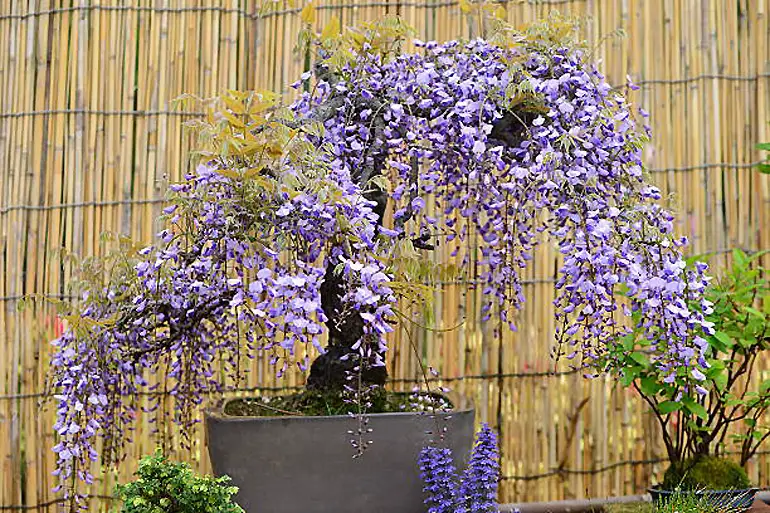
A Westeria Bonsai can grow as tall as 1 to 2 ft occupying a circumference of 18 inches with the flowers growing up to 0.30m long.
Is Wisteria Bonsai a fast-growing tree
Yes, Wisteria Bonsai is a fast-growing tree. If you are a fan of fast-growing bonsai, you may also love pittosporum bonsai, royal poinciana bonsai, cape honeysuckle bonsai, money tree bonsai and bonsai birch tree.
How long do Wisteria Bonsai live
A Wisteria Bonsai can live more than 50 years. Some even say a Wisteria tree can live up to two centuries and a half.
Does Wisteria Bonsai have flowers
Yes, Wisteria Bonsai have flowers. In fact, their popularity among Bonsai enthusiasts is a result of their flowery features. These flowers could be purple, white, pink, and blue depending on which variety is cultivated. The flowers are also known for their pea-like fragrance.
Is Wisteria Bonsai poisonous
Yes, Wisteria Bonsai is poisonous. The seeds and pods of a Wisteria Bonsai are poisonous to both humans and animals when ingested. Therefore, you must place your Wisteria Bonsai away from the reach of your pets and children.
Frequently Asked Questions
Does Wisteria kill trees?
Yes, wisteria can kill your tree. Wisteria plants are climbers, which means they twist around other trees or any object that blocks their way as they grow. However, although they may look pleasing to the eyes, they operate like snakes. Even though they cannot constrict your tree, they can strangle them to death.
How long do blue wisteria Bonsai bloom?
It takes about 3 years for a Blue Moon Wisteria bonsai raised under good condition to bloom.
Can you get cuttings from Wisteria?
Yes, can get cuttings from a wisteria Bonsai. The best way to get cuttings from a wisteria Bonsai is during pruning. You can as well take the cuttings directly from the plant mainly for its rooting. However, you should know that the best wisteria cutting is the one taken from softwood. That is woods that are still very much green and have not grown woody backs.
Where does Wisteria grow best?
Wisteria Bonsai grows best in moist, fertile, and well-draining soil under full sun. And should be planted away from other plants because of its intrusive nature.
Which Wisteria is evergreen?
Millettia reticulata is popularly known as Evergreen wisteria. This tree is native to Southern China and Taiwan and is known for its great fragrant, pleasing appearance, and will make an amazing alternative to the Chinese wisteria.
Where does Chinese wisteria grow?
Like most other spices, the Chinese wisteria will thrive better under full sun, moist, fertile, and well-draining soil.
Does wisteria have deep roots?
The roots of wisteria are both aggressive and deep. Wisteria plants grow into a huge vine, and therefore need an aggressive root system to dig deep and spread wide to be able to withstand such massive structure. And that is why it is not advisable to plant wisteria trees close to walls or pathways as they can destroy them.
Does Wisteria need lots of suns?
Yes, Wisteria requires lots of suns. Wisteria is a flowery plant and therefore requires full sun before it can bloom. Although your wisteria Bonsai will grow when planted in a partly shaded place, but might not flower as it should. Hence, you desire to have bloomy flowers, you need to expose your Wisteria Bonsai to a lot of suns.
Can you change the color of a Wisteria?
No, you cannot change the color of a wisteria Bonsai. Wisteria colors vary based on species, therefore, if the color of your wisteria is different from the color that particular species is known to have, then your tree is lacking in some key minerals or sun.
Is Wisteria a tree or a vine?
Wisteria is a vine.
When does Wisteria bloom in New Orleans?
Wisteria will bloom in New Orleans around April/May.
Do I need a trellis for Wisteria?
Yes, you need a trellis for wisteria. Wisteria is a vigorous climber and therefore, you need to support their growth with trellis or wires put on the walls or a garden structure.
Why do demons hate wisteria?
That is simply because the wisteria flowers contain very powerful medicinal properties and the concentrated odor of the flower can repel demons.
![Pittosporum Bonsai [Pittosporum Tobira]](https://www.bonsai-express.com/wp-content/uploads/2022/05/Pittosporum-Bonsai-365x200.jpg)
![Sorbus Bonsai [Sorbus Aucuparia]](https://www.bonsai-express.com/wp-content/uploads/2022/05/Sorbus-Bonsai-365x200.jpg)
![Tsuga Bonsai [Tsuga Canadensis]](https://www.bonsai-express.com/wp-content/uploads/2022/05/Tsuga-Bonsai-365x200.jpg)
![Tamarix Bonsai [Tamarix Ramosissima]](https://www.bonsai-express.com/wp-content/uploads/2022/05/Tamarix-Bonsai-365x200.jpg)